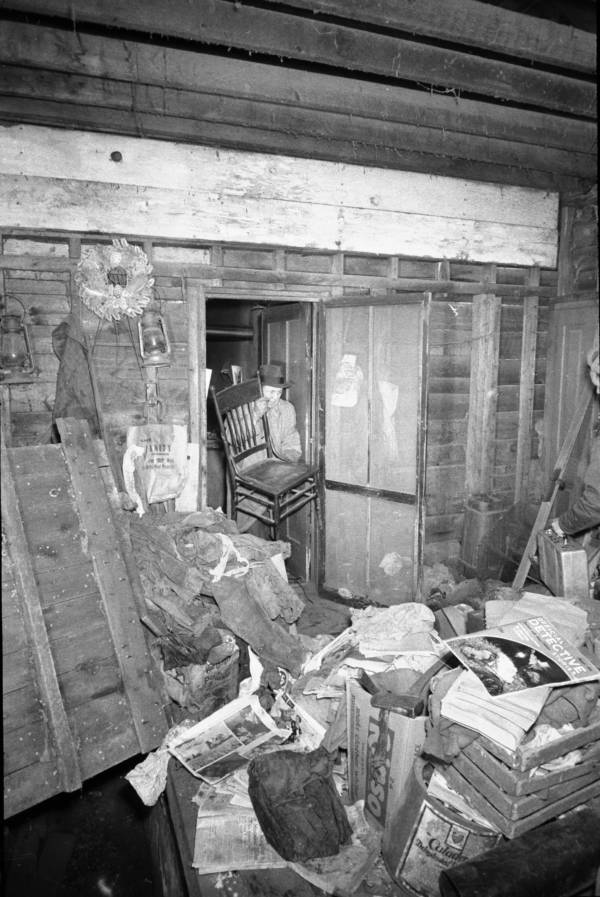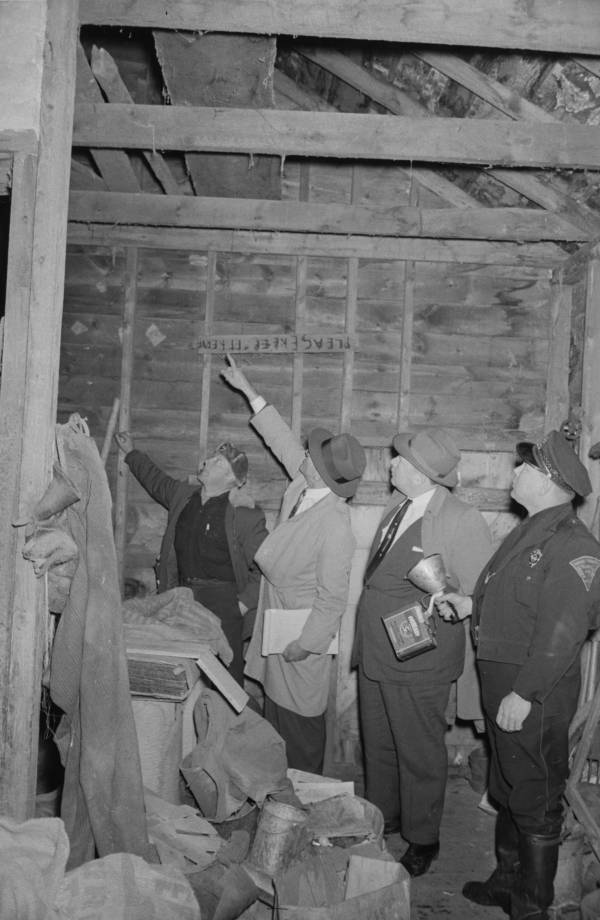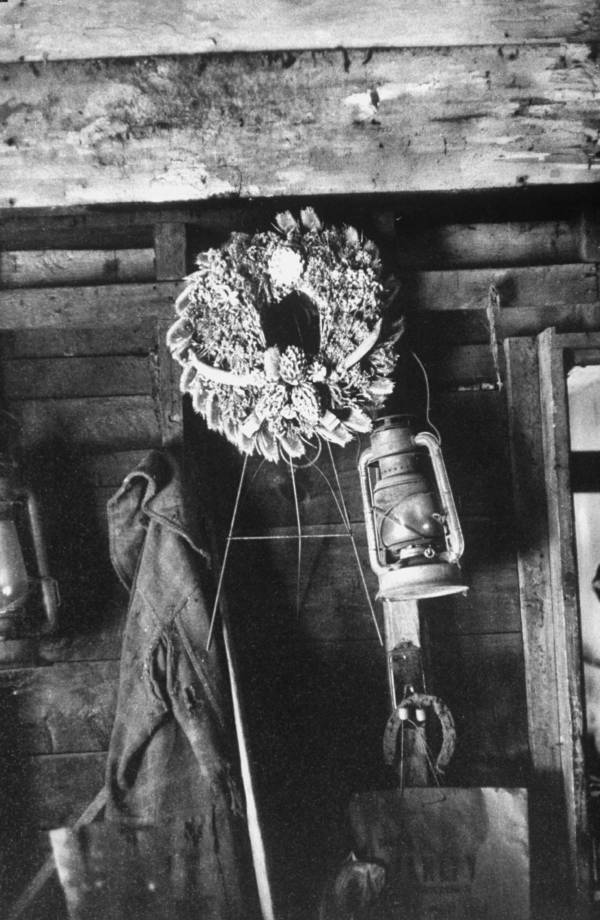Unveiling The Truth: Ed Gein Crime Scene Photos & Horrors
Could the genesis of modern true crime, with its obsession with the macabre and the exploration of the darkest recesses of the human psyche, truly be traced back to a single, isolated farmhouse in rural Wisconsin? The discovery of Ed Gein's home, a veritable chamber of horrors, marked a turning point, birthing a fascination with serial killers that continues to grip the public's imagination to this day.
The narrative surrounding Ed Gein, a name synonymous with unspeakable acts, is one of morbid fascination and chilling consequences. The very mention of the "Butcher of Plainfield" conjures images of grotesquery and a mind shattered by trauma and twisted by obsession. His crimes, committed in the quiet town of Plainfield, Wisconsin, during the 1950s, sent shockwaves through the nation and beyond, influencing countless works of art and cementing his place in the annals of criminal history. The details of his actions, the desecration of graves, the creation of bizarre artifacts from human remains these elements combined to create a monster whose story remains a potent mix of horror and psychological intrigue. The house itself became a macabre museum, filled with objects that spoke of a shattered soul and a life lived in the shadows.
| Category | Details |
|---|---|
| Full Name | Edward Theodore Gein |
| Born | August 27, 1906, La Crosse County, Wisconsin, USA |
| Died | July 26, 1984 (aged 77), Mendota Mental Health Institute, Madison, Wisconsin, USA |
| Crimes | Murder, grave robbing, body desecration |
| Victims | Confirmed: Mary Hogan, Bernice Worden. Suspected: Several others. |
| Motive | Fascination with death, desire for female companionship (often stemming from the loss of his mother), and mental instability. |
| Methods | Grave robbing to obtain bodies. Murder, dismemberment, and the creation of macabre artifacts from body parts. |
| Legal Status | Found not guilty by reason of insanity for the murder of Bernice Worden. Committed to a mental institution. |
| Inspiration for | Fictional characters: Norman Bates (Psycho), Buffalo Bill (The Silence of the Lambs), Leatherface (The Texas Chainsaw Massacre). |
| Notable Locations | Plainfield, Wisconsin (Farmhouse and surrounding area), Central State Hospital (later Mendota Mental Health Institute) |
| Relevant Link | Biography.com: Ed Gein |
The discovery of Gein's farmhouse in November of 1957 was a pivotal moment. When authorities entered the isolated dwelling in Plainfield, Wisconsin, they stumbled upon a scene that defied comprehension. The home, a seemingly ordinary structure from the outside, concealed a horrifying collection of macabre trophies. The ghastly souvenirs, crafted from the remains of the deceased, spoke volumes about Gein's fractured psyche and his descent into the abyss. The presence of these objects, meticulously arranged within the confines of his home, provided a stark and chilling illustration of the depths of human depravity. The reclusive nature of Gein, coupled with the gruesome finds inside his house, quickly turned the rural Wisconsin town into a focal point of national attention, thrusting it into the spotlight of a true crime narrative that remains compelling and unsettling.
The investigation into Gein's activities began with the disappearance of Bernice Worden, a Plainfield hardware store owner. Her disappearance, coupled with the existing suspicions surrounding Geins odd behavior and isolated lifestyle, provided the necessary impetus for law enforcement to search his property. The subsequent discovery of Worden's body, along with other shocking artifacts, quickly escalated the case from a missing person inquiry to a full-blown investigation into a serial killer. This included the discovery of Mary Hogan, a tavern owner, in a similar situation of death. The events in Plainfield exposed a previously unseen level of criminal behavior, capturing the public's imagination and setting a new standard for the depiction of depravity in true crime narratives.
The legal proceedings surrounding Ed Gein were as complex and disturbing as the crimes themselves. Found not guilty by reason of insanity in the 1957 slaying of Bernice Worden, Gein was subsequently recommitted to the Central State Hospital. The sanity hearings in Wood County Circuit Court became public spectacles, drawing crowds eager to witness the unfolding drama. The legal process, and the resulting judgment, reflected the complex nature of Geins mental state. The decision highlighted the challenges in dealing with individuals whose actions were driven by severe mental illness rather than malice, an early example of how the justice system would grapple with the intricacies of such cases. These hearings provided a window into a mind fractured by trauma and obsession, an illustration of the delicate balance between justice and compassion when confronting such extreme cases.
The influence of the Ed Gein case extends far beyond the courtroom and the crime scene. Its a story that has arguably become the bedrock of true crime culture and its pervasive influence on artistic media. The case's grim details, the disturbing artifacts, and the sheer strangeness of Gein's character inspired numerous works of art, including some of the most iconic and influential horror and thriller films ever made. The echoes of his actions can be heard in the chilling character of Norman Bates in Alfred Hitchcock's "Psycho" (1960), the grotesque Leatherface in "The Texas Chain Saw Massacre" (1974), and the equally disturbing Buffalo Bill in "The Silence of the Lambs" (1991). Geins story is more than a record of horrific acts; it has become a foundation upon which narratives of terror are built, defining a genre and shaping the public's perception of crime and madness.
The true crime genre, with its podcasts, documentaries, and countless articles, frequently revisits the case, seeking to understand the forces that shaped Gein's descent into depravity. The interest remains strong due to the fundamental human drive to comprehend the dark side of human nature. The case serves as a compelling lens through which to explore the complexities of mental illness, the impact of trauma, and the fragility of the human psyche. The continued examination of his life and crimes serves as a reminder of the capacity for both good and evil that resides within the human heart.
The rural setting of Plainfield, Wisconsin, adds another layer of complexity to the narrative. The isolation of the farmhouse, the small-town environment, and the quiet lives of its residents all contributed to the shock and horror that followed the discovery of Gein's crimes. The stark contrast between the idyllic facade of the community and the gruesome reality hidden within Gein's home is what has continued to capture the imagination of those drawn to the macabre. The setting serves as a powerful reminder that evil can emerge anywhere, even in the most ordinary of locations. The juxtaposition between the familiar and the horrifying is a recurring theme in true crime, and the Gein case exemplifies this duality perfectly.
The case's notoriety and ongoing interest are also a testament to the power of crime scene photos. While often unsettling, these images provide a visual connection to the reality of the crimes, forcing viewers to confront the stark truth of the events. Although, the actual "crime scene photos" are difficult to acquire due to their highly sensitive nature, any photographic evidence available offers a glimpse into the world of Ed Gein, and into the physical manifestation of his crimes. This is why they are so captivating. The visual evidence provides a tangible link to the past. The details of the crime scene, from the arrangement of objects to the condition of the bodies, become crucial evidence in painting a picture of Geins actions.
The lack of easily accessible "crime scene photos" has, in some ways, increased the mystery surrounding the case, forcing those interested to rely on written accounts, artistic interpretations, and limited available imagery. This lack of immediate visual access heightens the sense of mystery and creates an enduring puzzle for true crime enthusiasts. The scarcity of images only intensifies the allure, as the details become more tantalizing and the speculation more fevered. The absence of extensive photographic evidence has paradoxically strengthened the story's hold on the public imagination, fostering a desire to understand the events that shaped the events.
The role of Ed Geins upbringing, particularly his relationship with his mother, Augusta, has been a significant factor in the case. Augusta Gein's strict control and religious fanaticism, coupled with the early loss of his father, profoundly affected Ed. It is often posited by biographers that Augustas death in 1945 was a devastating blow, leaving him bereft and alone. The subsequent years saw Gein retreating further into his isolated world, fueled by grief and a deep-seated psychological instability. The focus on the mother-son dynamic and the impact of parental control on the formation of a twisted character, provides an emotional backdrop for the crimes, and helps explain his fascination with women and their bodies.
The case of Ed Gein continues to fascinate and disturb, inspiring countless works of art and shaping the evolution of the true crime genre. It provides a lens through which to examine the darkest corners of the human psyche. His name remains etched into the collective consciousness, a chilling reminder of the horrors that can be hidden in plain sight. From the discovery of the ghastly souvenirs to the legal proceedings, the Ed Gein case is a compelling example of the power of true crime narratives and their ability to simultaneously terrify and fascinate. The continuing interest in Gein's crimes is a testament to the enduring power of the narrative. It stands as a dark monument to a disturbed individual and a society grappling with the complexities of crime, mental illness, and the enduring search for understanding.



Detail Author:
- Name : Zola Carter
- Username : emmerich.dustin
- Email : schmitt.jerad@cartwright.com
- Birthdate : 1987-05-02
- Address : 44261 Cummerata Gateway Lake Carmelbury, SC 83351-4012
- Phone : 1-850-461-2215
- Company : Konopelski, Smith and Renner
- Job : Network Admin OR Computer Systems Administrator
- Bio : Voluptas et deserunt impedit maiores accusantium voluptatem sit consectetur. Commodi quis odit voluptates. Voluptas vel consectetur occaecati ut qui delectus. Porro et officiis laborum.
Socials
instagram:
- url : https://instagram.com/reva4756
- username : reva4756
- bio : Quod quas autem earum est corporis in. Eum deleniti ea in enim aliquam eveniet repellendus ea.
- followers : 548
- following : 2122
facebook:
- url : https://facebook.com/thielr
- username : thielr
- bio : Ut quod enim maiores ut quis. Exercitationem eaque laborum eum.
- followers : 6800
- following : 1329